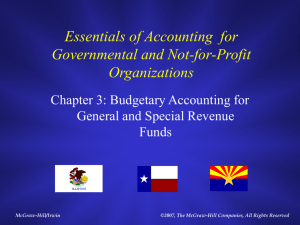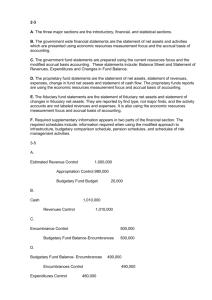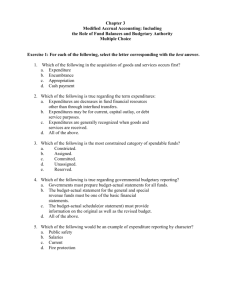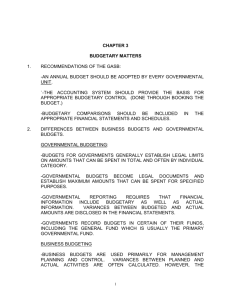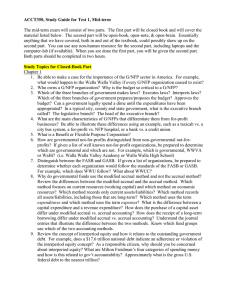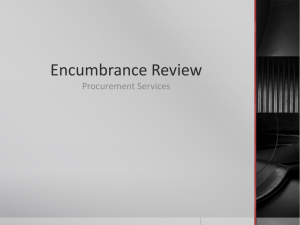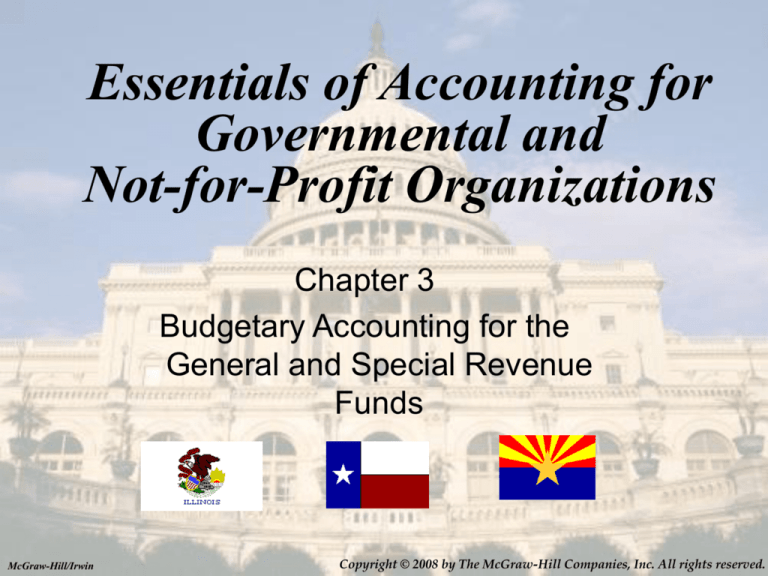
Essentials of Accounting for
Governmental and
Not-for-Profit Organizations
Chapter 3
Budgetary Accounting for the
General and Special Revenue
Funds
McGraw-Hill/Irwin
Copyright © 2008 by The McGraw-Hill Companies, Inc. All rights reserved.
Overview of Chapter 3
Importance of budgets in government
accounting
Recording the budget in the accounts
Overview of property taxes
Interfund transactions and other financing
sources
3-2
Importance of Budgets
Net income is NOT a good measure of
government effectiveness
Excess of revenue over expenditure does NOT
mean success, but indicates whether the funds
received are in excess of the funds expended
Since the funds received are often the result of
nonexchange transactions, Tax Revenues are not
equivalent to Sales as a measure of success in the
marketplace
3-3
What Is the Budget?
A budget is a financial plan submitted
to the appropriate body for approval
Once approved, budgets carry the
status of law
When voted upon, an appropriation act
gives the legal authority to spend and
generally sets the maximum limit for
spending
3-4
Importance of Budget Reporting
The primary means of financial control by
the government is the budget
The financial report should answer the question,
“Did the government use its funds as promised?”
Budget amounts are incorporated in accounting
records of the General Fund and special revenue
funds to provide information that will keep the
spending within the legal limits
3-5
Uses of Budgets
Governments must adopt an annual budget
General funds and Special Revenue funds will
have separate budgets. Separate budgets are
optional for other governmental funds and are
not used for proprietary and fiduciary funds.
Budgetary accounting principles are the same
for any governmental type fund which adopts
an annual budget
3-6
The General Process of Putting
Together a Budget
Plan the expected inflows
Plan the expected outflows
Project revenues based on past history, economic models,
etc
Ask departments for their projected needs
Balance the inflows and the outflows
Look for places to increase revenues or to cut spending
Governments may also borrow or use accumulated
surpluses to balance inflows and outflows
3-7
Budgetary Accounting –
New Account Titles
Estimated Revenues
Appropriations
Budgeted spending -- credit balance
Encumbrances
Budgeted inflows -- debit balance
Commitments (e.g. purchase orders) outstanding -debit balance
Reserve for Encumbrances
Restriction on fund balance -- credit balance
3-8
Recording the Budget
Assume $1,000,000 of revenues are budget along
with $950,000 of estimated expenditures
The budget entry would be
Estimated Revenues 1,000,000
Appropriations
Budgetary Fund Balance
950,000
50,000
Alternatively, estimated revenues and appropriations could
be recorded in separate entries
3-9
Incorporating Other Financing Sources
and Uses in Budget Entry
Assume a city budgets property tax revenues of $2,000,000;
bond proceeds of $1,000,000; expenditures of $2,800,000;
and a transfer to another fund of $100,000
The budget entry would be
Estimated Revenues
2,000,000
Estimated Other Financing Sources 1,000,000
Appropriations
Estimated Other Financing Uses
Budgetary Fund Balance
2,800,000
100,000
100,000
3-10
Why Record Encumbrances?
In business accounting, orders are not
entered into the general ledger
Governments recognize that an
outstanding order will turn into an
expenditure and a liability when the goods
arrive
To prevent over-spending outstanding
orders are entered into the books
3-11
Recording Outstanding Orders
Place an order for $150,000 which consists of three
mini-buses costing $50,000 each. Recorded as:
Encumbrances
150,000
Reserve for Encumbrances
150,000
Assume two of the buses arrive, but with freight, they
cost $102,000 instead of $100,000.
First, reverse a part of the encumbrances:
Reserve for Encumbrances
Encumbrances
100,000
100,000
Second, record the actual amount of expenditure:
Expenditure
Accounts Payable
102,000
102,000
3-12
Budget Revisions
Budget revisions may be
necessary during the year
due to changes in revenue
projections or operating
conditions … for example,
electricity price increases,
decrease in sales taxes
due to low consumer
spending
Budget revisions usually
are taken back to the
appropriate legislative
body for approval,
although some
jurisdictions may allow
some percentage of the
budget to be transferred
between accounts
3-13
Budgetary Comparison Schedule
Both the original and the final adjusted
budget is shown
The revised appropriations are compared to
the Actual Expenditures for the current
period plus Outstanding Encumbrances
A variance column is typically shown, but is
optional
3-14
Budgetary Comparison Schedule
The actual column
should use the basis of
accounting assumed in
the budget. This may
be different than
GAAP basis
Another schedule will
reconcile the ‘actual’
figures on the
budgetary vs. GAAP
basis
3-15
Classification of Inflows and
Outflows on Budget Schedule
Revenues are classified by source
Where the money came from: taxes, licenses and
permits, charges for service, etc
May be subdivided further such as by type of tax,
sometimes shown in separate schedule
Expenditures and Encumbrances may be
classified by
function, program, department, activity, character, or
object
3-16
Outflow Classifications
Character groupings are always: CURRENT,
CAPITAL OUTLAY, and DEBT SERVICE
Current may be classified by function: General
government, public safety, streets and highways
Public safety could be subdivided by department: Police
and fire
Police could be subdivided further by activity: Traffic and
drug enforcement
Activities in the traffic area could be divided into objects of
expenditure: Policeman’s salary, gas for automobiles
3-17
Property/ad valorem Taxes
Ad valorem taxes are based on the
assessed value of an underlying asset and
are a major type of tax, particularly at the
local government level
All real property bought and sold is typically
registered at the county courthouse and
subject to property tax
The tax is based on the tax rate, often
expressed as a millage rate, times the
assessed value
3-18
Millage and Assessed Value
A mill is
Appraised value
1/1000 of a dollar, or 1/10 of a penny
In other words, $.001 times some amount
Is calculated based on size of home, lot, etc.
Ideally, should approximate market value
Assessed value is usually less than
appraised value … often around 20-30% of
appraised value
3-19
Property Tax Calculation
Assume a home has an appraised
value of $100,000; 20% assessed
value rate; tax rate is 45 mills
Assessed value:
$100,000 X .20 = $20,000
Tax amount would be:
45 mills X 20 thousands = $900
Or, $20,000 X .045 = $900
3-20
How Is the Millage Rate Set?
In some areas all property taxes are
subject to a direct vote
In other areas the property tax is adjusted
each year (subject to possible maximum
amounts) to meet expenditure needs
Illustration 3-5 presents a calculation to
determine the property taxes needed to
balance the budget
3-21

